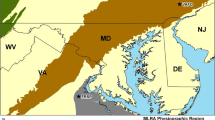Abstract
Wetlands can provide significant environmental benefits such as assimilation of pollutants, flood water storage, groundwater recharge, and fish and wildlife habitat. Geographically isolated wetlands (IWs) can provide the same benefits as other wetlands, but are particularly vulnerable to losses from urbanization and agriculture since they are isolated, often smaller, and not equal to other wetlands in regulatory protection. There is a need for a reliable assessment of the total number and area of IWs. Access to this information can provide the foundation to monitor IW loss, and can assist in understanding the ecological effects of such loss as well as help to address regulatory shortcomings. A probability sampling survey methodology that balances statistical considerations, expert opinion, and operational considerations is discussed for assessing the accuracy of IW maps. A simulation exercise was used to illustrate how the proposed sampling methodology will produce reliable results in map accuracy assessment. A wetland map for the Lockwood Folly River watershed, in Brunswick County, NC, was created using historical and recent data and used as the sampling frame in the simulation exercise. An updated wetland map for the same watershed, showing exact locations of wetlands, was used to provide “ground-truth” observations based on wetland delineations approved by the U.S. Army Corps of Engineers. Survey-based accuracy estimates were calculated by comparing site classification differences obtained by using both the original and updated wetland maps.
Similar content being viewed by others
References
Brunswick County (2007). Unified development ordinance and zoning map. Bolivia, NC: Brunswick County Planning.
Cashin, G. E., Dorney, J. R., & Richardson, C. J. (1992). Wetland alteration trends on the North Carolina coastal plain. Wetlands, 12(2), 63–71.
Cochran, W. G. (1987). Sampling techniques. New York: Wiley.
Dahl, T. E. (2000). Status and trends of wetlands in the conterminous United States, 1986 to 1997. U.S. Washington, DC: Department of the Interior, U.S. Fish and Wildlife Service.
Dahl, T. E. (2006). Status and trends of wetlands in the conterminous United States, 1998 to 2004. Washington, DC: U.S. Department of the Interior, U.S. Fish and Wildlife Service.
Foody, G. M. (2002). Status of land cover classification accuracy assessment. Remote Sensing of Environment, 80, 185–201.
Jenness, J. (2006). Repeating shapes for ArcGIS. Jenness Enterprises. Retrieved 12 August 2007, from http://www.jennessent.com/arcgis/repeat_shapes.htm.
Kirkman, L. K., Golladay, S. W., Laclaire, L., & Sutter, R. (1999). Biodiversity in Southeastern, seasonally ponded, isolated wetlands: Management and policy perspectives for research and conservation. Journal of the North American Benthological Society, 18, 553–562.
Leibowitz, S. G. (2003). Isolated wetlands and their functions: An ecological perspective. Wetlands, 23, 517–531.
Leibowitz, N. C., Squires L., & Baker, J. P. (1991). Research plan for monitoring wetland ecosystems. EPA/600/3-91/010. Corvallis, OR: U.S. Environmental Protection Agency, Environmental Research Laboratory.
Leibowitz, N., Ernst, T. L., Urquhart, N. S., Stehmanm, S., & Roose, D. (1993). Evaluation of EMAP-wetlands sampling design using national wetlands inventory data. Corvallis, OR: U.S. Environmental Protection Agency, Environmental Research Laboratory.
Levy, P., & Lemeshow, S. (1999). Sampling of populations: Methods and applications (pp. 192–220). Canada: Wiley.
Moorhead, K. K., & Cook, A. E. (1992). A comparison of hydric soils, wetlands, and land use in coastal North Carolina. Wetlands, 12, 99–105.
NC Department of Environment and Natural Resources (1996). A field guide to North Carolina wetlands. Raleigh, NC: NC Department of Environment and Natural Resources.
NC Division of Coastal Management (1999a). Strategic plan for improving coastal management in North Carolina. An accuracy assessment of GIS wetland mapping in the coastal counties of North Carolina. Raleigh, NC: NC Division of Coastal Management.
NC Division of Coastal Management (1999b). NC coastal region evaluation of wetland significance (NC CREWS) (p. 119). Raleigh, NC: NC Division of Coastal Management.
NC Division of Water Quality (2003). Basinwide planning program. 2003 Lumber River basinwide water quality plan. Raleigh, NC: NC Division of Water Quality.
NC Division of Water Quality (2007). Basinwide information management system data. Raleigh, NC: NC Division of Water Quality.
NC Wetland Functional Assessment Team (2007). NC wetland assessment method (NC WAM) draft user manual. Raleigh, NC: NC Department of Transportation, NC Department of Environment and Natural Resources and US Army Corps of Engineers.
Nusser, S. M., & Klaas, E. E. (2003). Survey methods for assessing land cover map accuracy. Environmental and Ecological Statistics, 10, 309–331.
Richardson, C. (2003). Pocosins: Hydrologically isolated or integrated wetlands on the landscape? Wetlands, 23, 563–576.
Russell, K. R., Guynn, D. C., & Hanlin, H. G. (2002). Importance of small isolated wetlands for herpetofaunal diversity in managed, young growth forests in the coastal plain of South Carolina. Forest Ecology and Management, 163, 43–59.
Sarndal, C. E., Swensson, B., & Wretman, J. (1992). Model assisted survey sampling (p. 694). New York, NY: Springer.
Schafale, M. P., & Weakley, A. S. (1990). Classification of the natural communities of North Carolina (p. 191). Third approximation. (North Carolina Natural Heritage Program. Division of Parks and Recreation. Department of Environment and Natural Resources).
Sharitz, R. (2003). Carolina Bay wetlands: Unique habitats of the Southeastern United States. Wetlands, 23, 550–562.
Stehman, S. V. (1999). Basic probability sampling designs for thematic map accuracy assessment. International Journal of Remote Sensing, 20, 2347–2366.
Stehman, S. V., & Czapewiski, R. L. (2003). Introduction to special issue on map accuracy. Environmental and Ecological Statistics, 10, 301–308.
U.S. Army Corps of Engineers (1987). Corps of Engineers Wetlands Delineation Manual. Environmental Laboratory. Mississippi: Department of the Army. Technical Report Y-87-1 Waterways Experiment Station, Corps of Engineers.
Whigham, D. & Jordan, T. (2003). Isolated wetlands and water quality. Wetlands, 23, 541–549.
Author information
Authors and Affiliations
Corresponding author
Rights and permissions
About this article
Cite this article
Munoz, B., Lesser, V.M., Dorney, J.R. et al. A proposed methodology to determine accuracy of location and extent of geographically isolated wetlands. Environ Monit Assess 150, 53–64 (2009). https://doi.org/10.1007/s10661-008-0672-0
Received:
Accepted:
Published:
Issue Date:
DOI: https://doi.org/10.1007/s10661-008-0672-0




